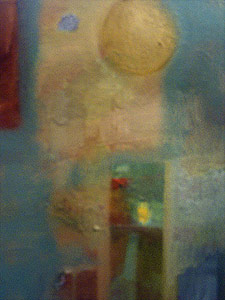
| HOME |
| NERVE |
| REVIEWS |
| ARCHIVE |
| EVENTS |
| LINKS |
| ABOUT US |
| CONTRIBUTORS |
| BACK ISSUES |
| CONTACT US |
 Hearts
and Minds
Hearts
and Minds
Red Dot Exhibitions
Liverpool Academy Of Arts,
Seel Street (7th-23rd May, Mon-Fri 12pm-4pm)
Reviewed by Adam Ford
The Red Dot collective's latest exhibition is a curious thing. All the artists on display have high levels of technical skill, but many retreat so far into abstraction that they exclude the viewer from having any meaningful interaction with their work, almost by definition.
Red Dot has always focused on abstract work, but somehow it has always seemed to be more evocative than much of the current batch, which is uniformly well done, but mostly uninspiring. However, several of the pieces stand out.
The art of John O'Neill is totally absorbing, as always. Alongside a painting I'd seen before - his Grosvenor-baiting 'Grand Old Duke of Regeneration' - there is another piece, 'Scouserazzi'. Like the German New Objectivists George Grosz and Otto Dix almost a century ago, O'Neill is consistently impressive in his ability to create biting, nightmare worlds, which are still instantly recognisable as parts of Liverpool.
Another oil painter, Alice Lenkiewicz's 'Nocturnal' series is another highlight. Though far more abstract that O'Neill, her material retains a definite mood, which can be appreciated or not by the viewer. As the name suggests, the colours are mostly dark, and suggested a drizzly dusk to me.
Jon D Nash contributes six pieces, but the most striking is his '4 Years at 20 a day' installation. Almost thirty thousand cigarettes spell out a stern warning to those thinking of taking up the habit. It is for sale, like all the other works, but the financial cost of Nash's smoking has been a head-spinning £14,955.00.
The best art has always been about self-indulgence. In an essay on the role of the artist, Oscar Wilde claimed that 'Art is the most intense mode of individualism that the world has known'. If that is true, then abstract artists must be the most individualistic of them all, since the idea of content and meaning is often forgotten, and form takes precedence. But artists and gallerygoers both inhabit a social world; they win and lose, experience pleasure and pain, love and hate. In an important sense, if artwork does not express this, it isn't self-expression at all, and the viewer has nothing to cling to beyond geometry. Though hearts are actually muscles that pump blood around the body, there is nowhere near enough 'heart' in this exhibition.